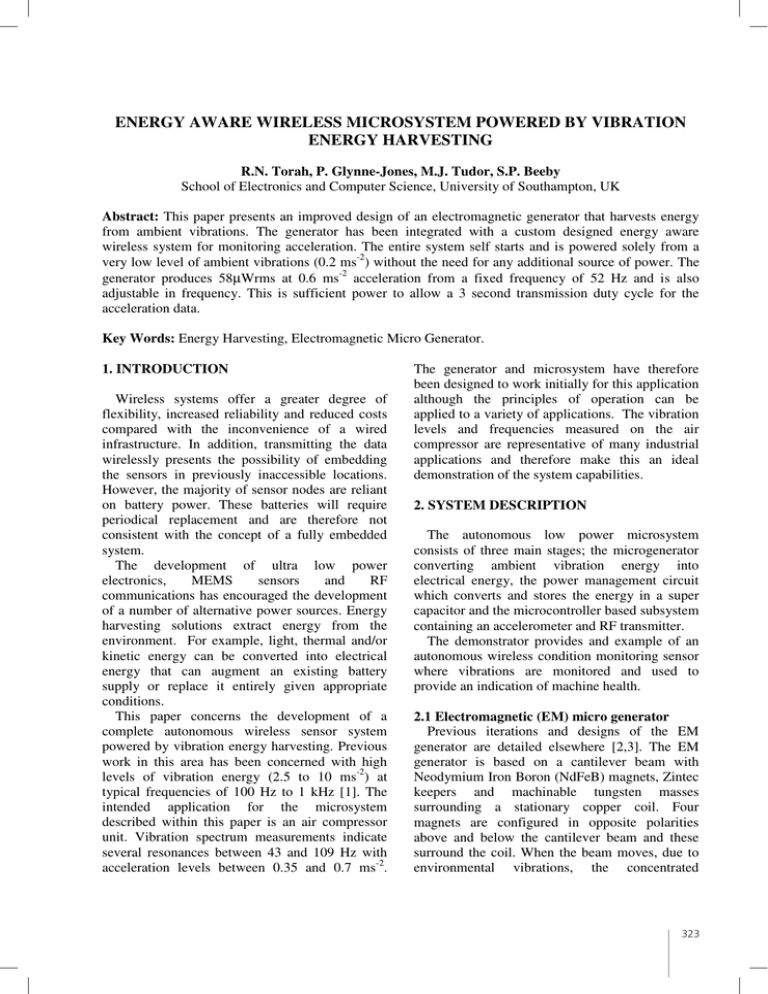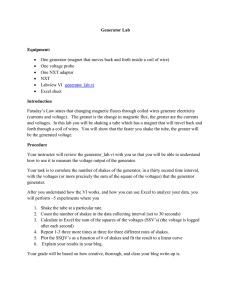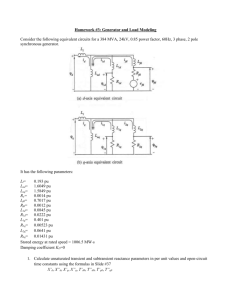ENERGY AWARE WIRELESS MICROSYSTEM POWERED BY VIBRATION ENERGY HARVESTING
advertisement

ENERGY AWARE WIRELESS MICROSYSTEM POWERED BY VIBRATION ENERGY HARVESTING R.N. Torah, P. Glynne-Jones, M.J. Tudor, S.P. Beeby School of Electronics and Computer Science, University of Southampton, UK Abstract: This paper presents an improved design of an electromagnetic generator that harvests energy from ambient vibrations. The generator has been integrated with a custom designed energy aware wireless system for monitoring acceleration. The entire system self starts and is powered solely from a very low level of ambient vibrations (0.2 ms-2) without the need for any additional source of power. The generator produces 58µWrms at 0.6 ms-2 acceleration from a fixed frequency of 52 Hz and is also adjustable in frequency. This is sufficient power to allow a 3 second transmission duty cycle for the acceleration data. Key Words: Energy Harvesting, Electromagnetic Micro Generator. 1. INTRODUCTION Wireless systems offer a greater degree of flexibility, increased reliability and reduced costs compared with the inconvenience of a wired infrastructure. In addition, transmitting the data wirelessly presents the possibility of embedding the sensors in previously inaccessible locations. However, the majority of sensor nodes are reliant on battery power. These batteries will require periodical replacement and are therefore not consistent with the concept of a fully embedded system. The development of ultra low power electronics, MEMS sensors and RF communications has encouraged the development of a number of alternative power sources. Energy harvesting solutions extract energy from the environment. For example, light, thermal and/or kinetic energy can be converted into electrical energy that can augment an existing battery supply or replace it entirely given appropriate conditions. This paper concerns the development of a complete autonomous wireless sensor system powered by vibration energy harvesting. Previous work in this area has been concerned with high levels of vibration energy (2.5 to 10 ms-2) at typical frequencies of 100 Hz to 1 kHz [1]. The intended application for the microsystem described within this paper is an air compressor unit. Vibration spectrum measurements indicate several resonances between 43 and 109 Hz with acceleration levels between 0.35 and 0.7 ms-2. The generator and microsystem have therefore been designed to work initially for this application although the principles of operation can be applied to a variety of applications. The vibration levels and frequencies measured on the air compressor are representative of many industrial applications and therefore make this an ideal demonstration of the system capabilities. 2. SYSTEM DESCRIPTION The autonomous low power microsystem consists of three main stages; the microgenerator converting ambient vibration energy into electrical energy, the power management circuit which converts and stores the energy in a super capacitor and the microcontroller based subsystem containing an accelerometer and RF transmitter. The demonstrator provides and example of an autonomous wireless condition monitoring sensor where vibrations are monitored and used to provide an indication of machine health. 2.1 Electromagnetic (EM) micro generator Previous iterations and designs of the EM generator are detailed elsewhere [2,3]. The EM generator is based on a cantilever beam with Neodymium Iron Boron (NdFeB) magnets, Zintec keepers and machinable tungsten masses surrounding a stationary copper coil. Four magnets are configured in opposite polarities above and below the cantilever beam and these surround the coil. When the beam moves, due to environmental vibrations, the concentrated 323 magnetic flux lines cut through the stationary coil and power is generated. The generator design has been modified compared to the previous generator. Ansoft Maxwell 3D magnetic modelling software showed that increasing the velocity of the magnets, for a given frequency, and increasing the electromagnetic coupling would further improve the generated output voltage. To achieve an increased velocity, from a given frequency, the inertial mass has been moved closer to the clamping point with the magnets further away. This maximises the mechanical amplitude, and therefore the velocity, of the magnets in relation to the stationary coil. Figure 1 shows a comparison of the previous Mk2 and latest Mk3 generator designs. Mk2 Generator Beam Mass Magnets Base Coil ANSYS static stress finite element analysis. A maximum peak displacement of 1.8 mm (0.85 mm at the centre of the magnets) ensures the fatigue limits of the material will not be exceeded. This result was used to calculate the remaining dimensions of the generator and in the Ansoft model. Adjustment of the generators resonant frequency can be achieved by altering the cantilever beam length. ANSYS modal analysis showed that an adjustment of 1.3 mm would produce a frequency range of 44-60 Hz. Therefore, a slot was etched into the beam at the clamping point to allow for manual adjustment of the beam length. In addition, the slot in the beam for the coil was increased in length to allow for this extra movement. Additionally, the rearrangement allowed for a larger coil to be used whilst maintaining the same generator volume, ~150 mm3. The new copper coil has outer and inner diameters of 2.8 mm and 0.5 mm respectively. It is wound with 12 m diameter copper wire achieving 2800 turns and a coil resistance of 2.3 k. The output power is further improved by increasing the electromagnetic coupling within the generator. The length of the magnets is 3.7mm to ensure that the coil is always entirely within the magnetic flux irrespective of beam length adjustments. Finally, the horizontal gap between the magnets has been reduced by 0.1mm, increasing the flux density by 12%. This was the minimum gap size achievable whilst maintaining a reasonable yield of working generators. 2.2 Wireless microsystem An overview of the wireless microsystem is provided here, a more detailed explanation is presented elsewhere [5]. Mk3 Generator Fig. 1: Previous Mk2 generator and cutaway of the new Mk3 generator design. Because of the cyclical operation of the generator, the fatigue properties of the beam material have a particular significance. Beryllium copper was chosen for the beam material because it has high fatigue strength, 0.31 GNm-2 [4]. The maximum tip amplitude was identified using 324 Micro-Power Generator Power Convertor Energy Storage Sensor Processor Wireless Transmitter Power Data Flow Fig. 2: Block diagram for the microsystem. Figure 2 shows the block diagram for the micro system. The power converter consists of a 5 stage Dickson charge pump designed to function with the relatively low voltages produced by the generator. The components were selected by PSpice simulation and practical measurements. BAT754L low power Schottky diodes and 100 µF stage capacitors were proven to provide the optimum output in terms of final voltage and rapid charge time. A 0.047 F supercapacitor was chosen to store the energy from the generator. A supercapacitor avoids the extra circuitry, and unnecessary power losses, associated with a rechargeable battery. The accelerometer sensor (Analog Devices ADXL330) and wireless transmitter (RF Solutions AM-RT4) were selected for their low power consumption, low voltage requirements (2.2 V) and their level of functionality. A MicroChip PIC16F676 microprocessor was used because it can operate at 2.2 V and has a built in analogue to digital converter which is required to measure the output from the sensor. The PIC was programmed to operate in a low power sleep mode until the supercapacitor voltage reaches 2.2 V. The PIC periodically samples the voltage on the supercapacitor and once sufficient power is available, the PIC switches on the accelerometer, takes 15 measurements and records the peak acceleration value. This peak value is then sent to the transmitter module along with a synchronisation bit and identification byte to improve the signal to noise ratio at the receiver. Figure 3 shows the wireless microsystem with the Mk3 generator attached. The PCB is attached to the application using a magnetic mount. 3. RESULTS The generator performance was evaluated using an accelerometer feedback controlled shaker unit, a programmable resistive load and a PC with LabView software collecting the data. This system allows the user to obtain reliable, repeatable results and program long sequences of tests to fully characterise the generator over a range of acceleration levels, load resistances and frequencies. The resonant frequency was obtained by sweeping through a range of frequencies. Once the resonant frequency was identified the test was repeated with varying load resistances from 100 to 9 MΩ. The generator was subjected to a vibration acceleration of 0.6 ms-2 throughout the tests. The optimum power output of 58 µW was achieved with a 15 kΩ load resistance. The modelling predicted a peak open circuit voltage of 1.5 V whilst the practical generator produced 1.12 V. The generator was then connected directly to the voltage multiplier circuit and the output power was measured using a buffer amplifier. Figure 4 shows the power output curves for the generator output when connected to the optimum resistive load and when connected to the voltage multiplier circuit with no load resistor. Fig. 4: Maximum generated power into a resistive load of 15 k and into the voltage multiplier circuit, both at 0.6 ms-2vibration. Fig. 3: Wireless microsystem with the generator attached. During testing the PIC microcontroller drew significant amounts of power, in excess of the specified values, when the supply voltage reached 0.9 V preventing the system from working from a cold start. To overcome this problem, a Torex XC61C (consumption ~1.4 µW) voltage level 325 detector, with a specified switching voltage of 2 V, was connected between the storage capacitor and the microcontroller. Finally, the entire microsystem was tested and then demonstrated on the air compressor application, producing a transmission typically every 3 seconds. 4. DISCUSSION The results show that the voltage multiplier circuit is more efficient at extracting power from the generator, compared to a simple load resistor, thus significantly increasing the electrical damping. This is due to the improved electromagnetic coupling for the Mk3 generator compared to the Mk2 design. This is clearly shown in figure 4 by the broader, lower amplitude resonant peak. The broader bandwidth is preferable in many practical implementations allowing the generator to work for a wider range of vibration frequencies. Also, the increased electrical damping means that higher acceleration levels can be applied before reaching maximum deflection. The generator structure limits the beam motion using over range protection provided by the base and lid. The generator has been designed to be limited to acceleration levels of 0.6 ms-2. However, when connected to the voltage multiplier circuit the generator can be driven up to an acceleration level of 1.7 ms-2 before reaching maximum deflection at which point the power output is 120 µWrms. The generator was able to charge the supercapacitor in 4 hours from a cold start. The system is energy aware and simply modifies the measurement/data transmission duty cycle, therefore altering its power consumption, depending on the amount of energy being harvested. It works down to acceleration levels as low as 0.2 ms-2 at which point it transmits data every 12 minutes. 5. CONCLUSION This paper has demonstrated an improved electromagnetic micro generator design, with a power output increase from 46 µWrms to 58 µWrms and an improvement in output voltage from 450 mVrms to 931 mVrms with the optimum load resistance. This improved generator has been successfully integrated with an autonomous wireless micro 326 system. The system demonstrates many significant features such as energy awareness, low operating levels of vibration, cold start ability and vibration sensing simulating a real condition monitoring application. The vibration levels required to power the system can be widely found in many environments, in particular in industrial machinery applications. The system is currently able to measure acceleration data and transmit the result typically every 3 seconds when excited by vibration levels of 0.6 ms-2. The duty cycle is limited to 3 seconds due to the PIC program which allows sufficient excess charging of the supercapacitor to ensure a reasonably stable period of operation even when the generator is not operating at its maximum output level. This duty cycle could be reduced where required or alternatively the amount of measured data within this period could be increased to provide more information for the receiver. Future work will consider the integration of sensor signal analysis either as part of the autonomous system or by transmission of larger amounts of data for analysis to be performed at the receiver, thus improving the functionality of the system. 6. ACKNOWLEDGEMENTS The authors would like to acknowledge the funding from the EU for the project VIBES under which this work was carried out. REFERENCES [1] S.Beeby, M.Tudor, N.White, “Energy Harvesting Vibration Sources for Microsystem Applications”, Measurement Science and Technology, Vol. 17, No.12, pp. R175-R195, 2006. [2] R.N.Torah, S.P.Beeby, M.J.Tudor, T.O’Donnell, S.Roy. PowerMEMS’06, Digest of Technical Papers , 181-184, 2006. [3] S.P.Beeby, R.N.Torah, M.J.Tudor, P Glynne-Jones, T.O’Donnell, C.R.Saha S.Roy. J. of Micromech. Microeng. 17, 1257-1265, 2007. [4] http://www.ngk.co.jp/english/index.html, webpage accessed on Oct. 18, 2007. [5] R.N.Torah, M.J.Tudor, K. Patel, I.N. Garcia, S.P.Beeby, IEEE Sensors’07 Atlanta, Digest of Technical Papers, 2007.







